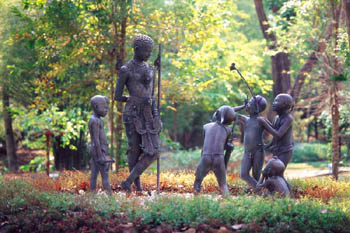|
| |
Sculpture
 Thai sculptors of the past concentrated almost exclusively on Buddha images,
producing works that rank among the world's greatest expressions of Buddhist
art. These have ranged in size from Sukhothai's gigantic seated Buddha at Wat Si
Chum, which measures 11 meters from knee to knee, to tiny, fingernail-sized
Buddhas worn as amulets. Their greatest achievements were during the Sukhothai
period, when the smoothness and sheen of cast metals perfectly matched the
graceful elongated simplicity of the basic from. To emphazise the spiritual
qualities of Buddhism. Thai sculptors eschewed anatomical details such as
muscles and bone structure. realizing that these would only distract from the
enigmatic serenity that was their gold.
Thai sculptors of the past concentrated almost exclusively on Buddha images,
producing works that rank among the world's greatest expressions of Buddhist
art. These have ranged in size from Sukhothai's gigantic seated Buddha at Wat Si
Chum, which measures 11 meters from knee to knee, to tiny, fingernail-sized
Buddhas worn as amulets. Their greatest achievements were during the Sukhothai
period, when the smoothness and sheen of cast metals perfectly matched the
graceful elongated simplicity of the basic from. To emphazise the spiritual
qualities of Buddhism. Thai sculptors eschewed anatomical details such as
muscles and bone structure. realizing that these would only distract from the
enigmatic serenity that was their gold.
Thai sculpture received a boost in 1933 when an Italian sculptor, Corado Feroci
founded the Fine Arts School which in 1943 became silpakorn University. Having
first arrived in Thailand in 1924 to work with the Royal Fine Arts Department on
the creation of monumental sculptures (such as the statue of King Tak Sin in
Thon Buri), Feroci is today remembered as the father of modern art in Thailand.
He became a Thai citizen in 1944, changing his name to silpa Bhirasri, and
served as Dean of the Painting and Sculpture Faculty until his death in 1962,
One of his adult students was Misiem Yipintsoi, who took up first painting and
then sculpture and achieved great success in the latter. Examples of her work,
much of which depicted children, can be seen in many private collections as well
as in a sculpture garden she established outside Bangkok.
Many modern Thai sculptors have experimented with the arthistic possibilities of
new methods borrowed from industrial technology to create works both simple and
incredibly complex in meaning and effect. Others have taken objects out of their
ordinary environment and turned them into arresting works of art. In one
exhibition at the art gallery of the National Museum, buffalo horns and hides,
rice sacks, dried rice stalks, sickles and other implements were used to create
the essence of being on a farm.
Lacquerware and Mother-of-Pearl Inlay
The art of making lacuer originally came to Thailand from China, probably by way
of Burma, but over the centuries distinctively Thai designs and techniques were
evolved. It became a notable handicraft in the northern province of Chiang Mai
and is still made there in a number of households.
Lacquerware begins with finely-woven bamboo basketry or well-seasoned wood which
has been carved or shaped on a lathe the desired shape, To this is first applied
a basic coating material called samook, consisting of the ashes of burnt
ricepaddy husks or ground clay mixed with rak, or black lacquer, obtained from a
tee which grows in the northern hills. When dry, this is polished with soapstone
and then another coating is applied. This process is repeated again and again
for up to fifteen times, building up a rigid base of durable lacquer. At the end,
a final polishing is given with a sandpaper-like leaf called bai-nod.
The object is then ready for several coats of pure black lacquer, from three to
six coatings. The final layer is polished with water and powdered fired clay,
giving it a glistening shine.
A design is then applied by either the method called lai kud or the one called
lai rot nam. If the object is to be in color, lai kud is used, while lai rot nam
is for objects with gold designs. At the end of the process the color or gold
stands out against a background of glossy black.
The use of mother of pearl to adorn objects has a long history in Thailand.
Stucco pieces embedded with bits of shell have been found at monuments dating
back to the Dvaravati period (6th to 11th centuries A.D.) and some form of the
art may have existed even before along the coastal region.
But these early efforts were crude compared with the magnificent works achieved
by techniques perfected in the late Ayuthaya and early Bangkokperiods, when
temple doors and windows, manuscript boxes, alms bowls, and numerous other items
were splendidly decorated by the painstaking process the |Thais call krueng
mook. The craft continues to thrive today in the production of exquisitely
detailed furniture, mirror frames, boxes, and trays that are the pride of many
owners both in Thailand and abroad.
The Thai mother-of-pearl inlay technique involves the patient cutting of the
luminescent muk fai, or flame snail, indigenous to the Gulf of Thailand. The
outer surface of this shell is removed with a special knife and the pearly inner
shell is cut into fairly flat pieces, each about two and a half centimeters
long. Sanded flat, they are glued to wooden surfaces to form patterns or scenes
and the area in between filled with lacquer.
|